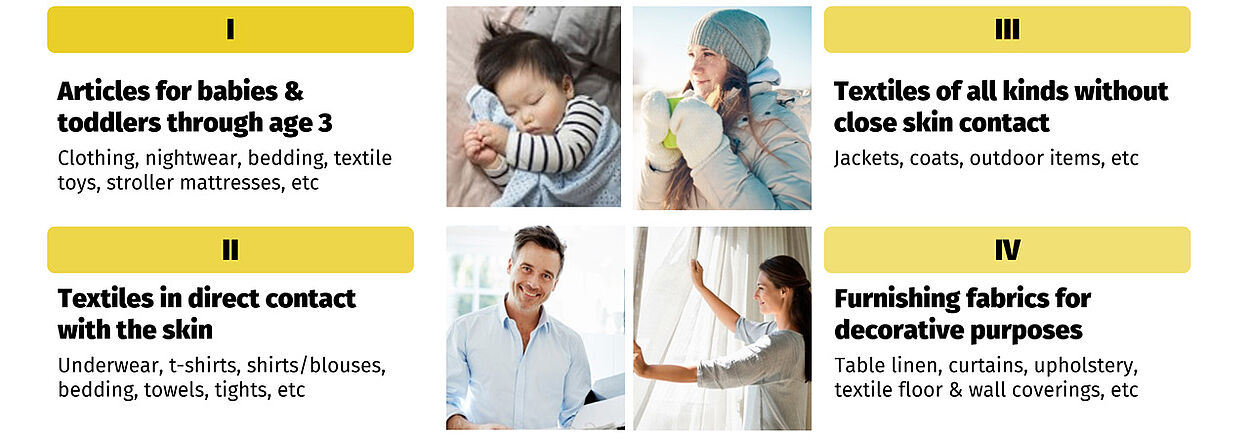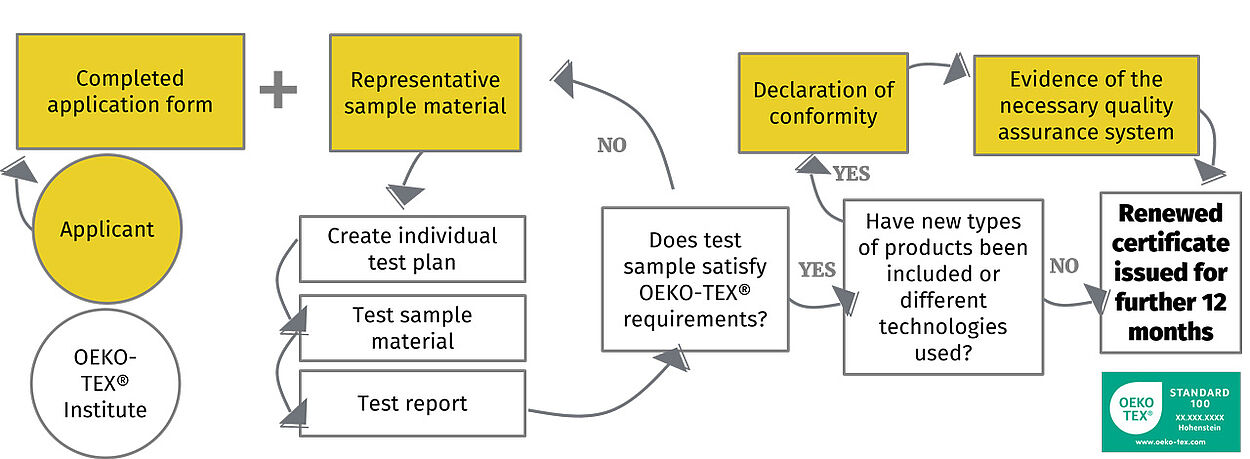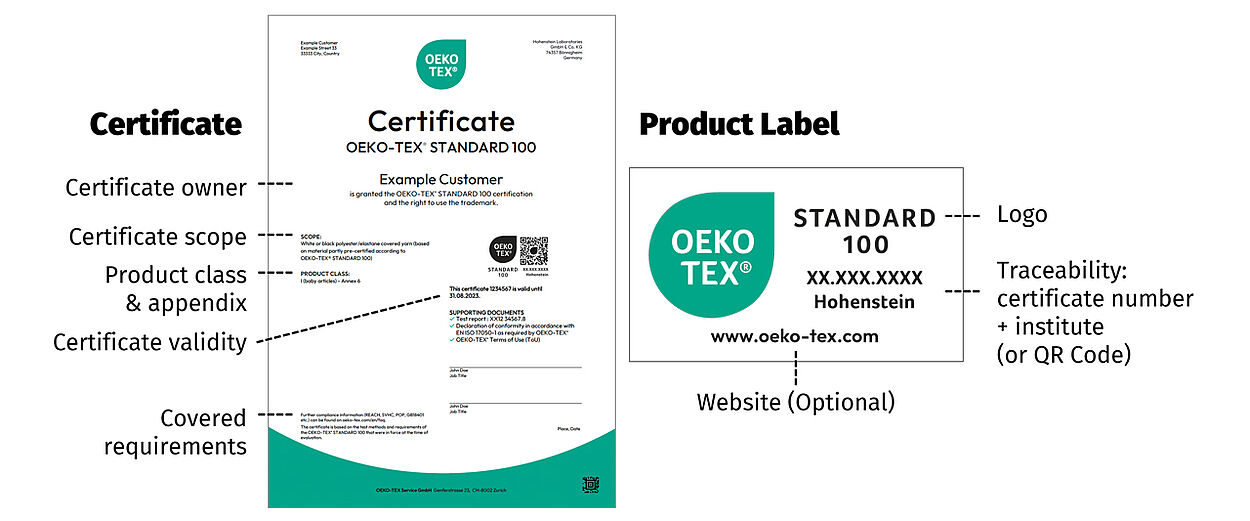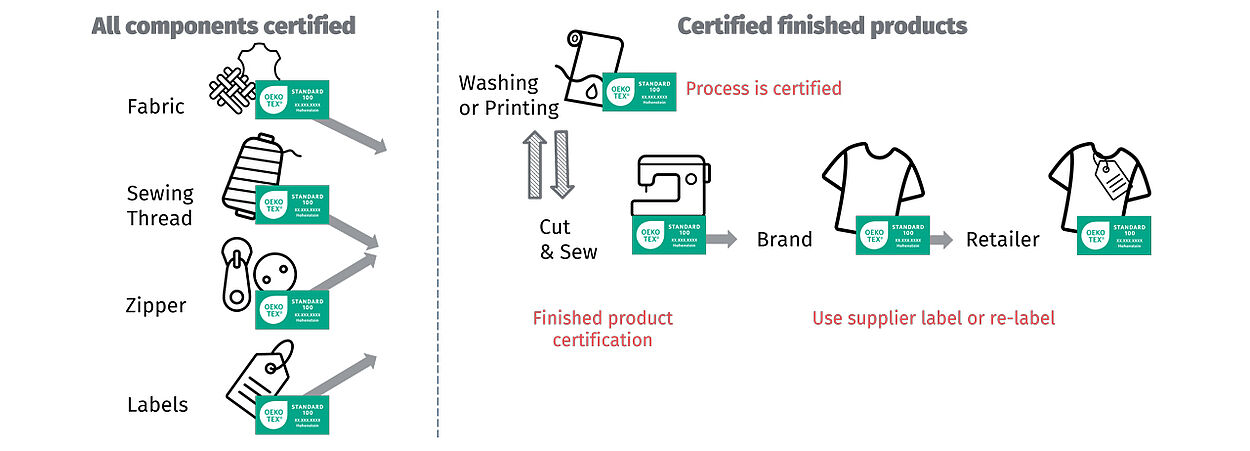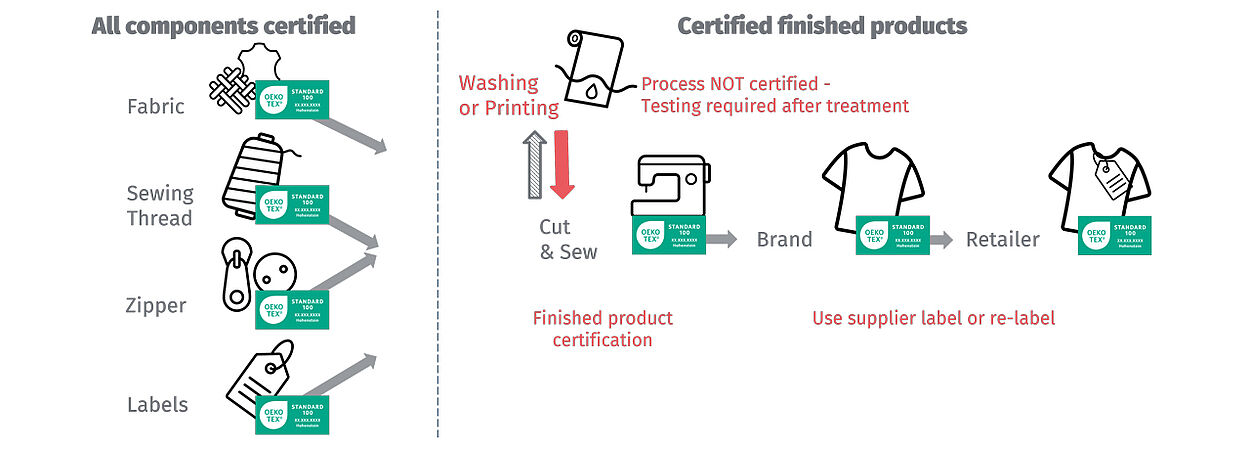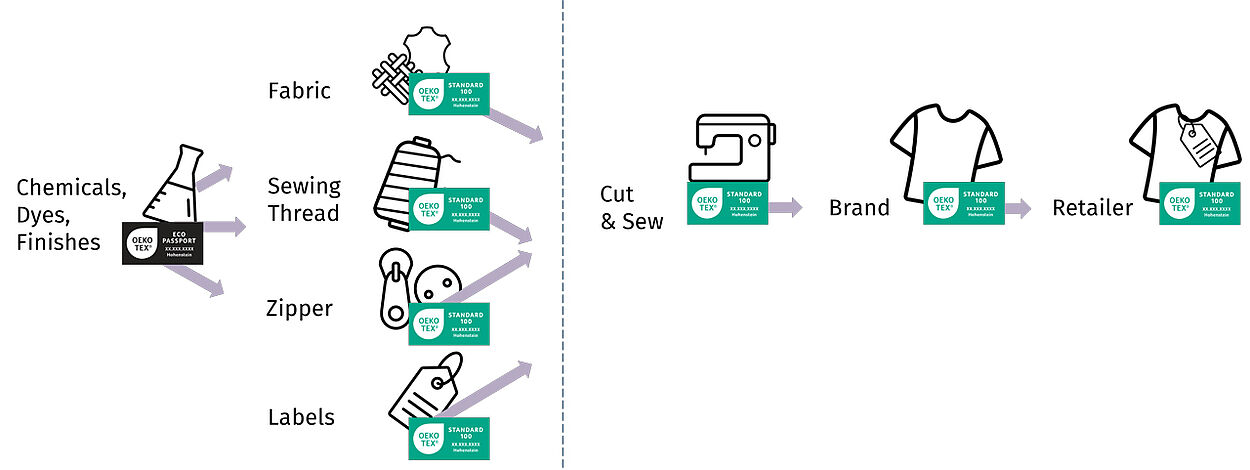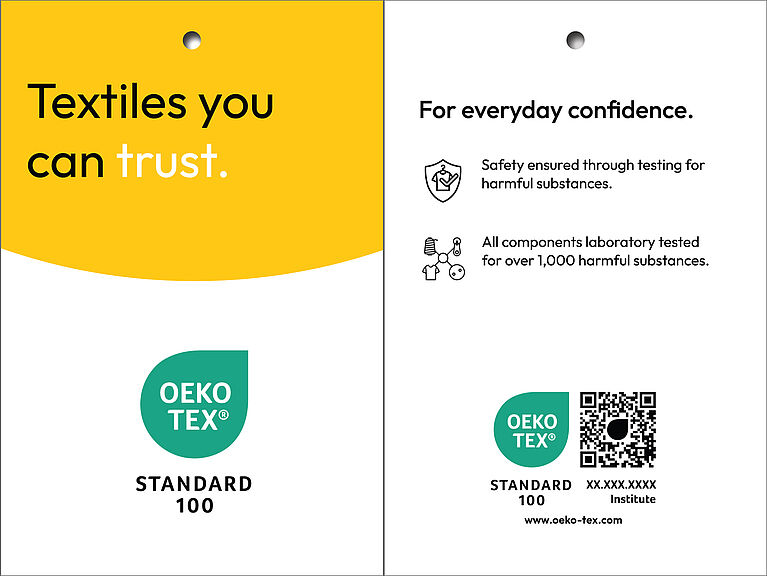What does OEKO-TEX® STANDARD 100 do?
- Gives consumers and purchasers a reliable, 3rd-party label for non-hazardous products that are tested in accordance with strict global standards to protect from harmful substances in textiles
- Provides targeted product stewardship support for companies in the textile chain with human-ecological product safety, based on a scientific criteria catalogue and neutral laboratory tests
- Simplifies and accelerates supplier relationships for manufacturers and retailers who want to ensure product safety for their customers
- Ensures legal conformity for importers, retailers and manufacturers
What claim does STANDARD 100 certify?
OEKO-TEX® STANDARD 100 certification means that a product, material, accessory or other textile related good, has been tested for substances that could harm human health. This standard protects people from toxics that are left on the product.
To make the claim on a finished good, the product and each of its components/inputs must be tested. This means claims of certification on ingredients (e.g. "the fabric in this product is certified") are NOT allowed.
Although a product that is safer for humans could also be better for the planet, STANDARD 100 is not an eco/sustainability claim. Sustainability is verified through the OEKO-TEX® MADE IN GREEN label, of which STANDARD 100 is an important part.
Does STANDARD 100 influence sustainability?
OEKO-TEX® STANDARD 100 is a product safety standard. However, limiting or restricting a chemical at the component level influences input chemistries and factories.
- The STANDARD 100 restricted substance list has continued to expand from 100 substances (in 1992) to over 1,000, including chemicals like formaldehyde, APEOs, PFCs and heavy metals that negatively impact humans. Many of these restricted substances also impact the planet
- STANDARD 100 limit values (output control) are directly tied to OEKO-TEX® ECO PASSPORT chemical certification (input control) - incentivizing the use of certified chemistries, which means better chemistries are being used from the beginning
- ECO PASSPORT then influences chemicals going into OEKO-TEX® STeP certified factories (process control)
- Low and enforced limits in products via STANDARD 100 are an important systems approach to limiting the negative impacts of chemicals on consumers, while influencing responsible chemical management throughout the supply chain
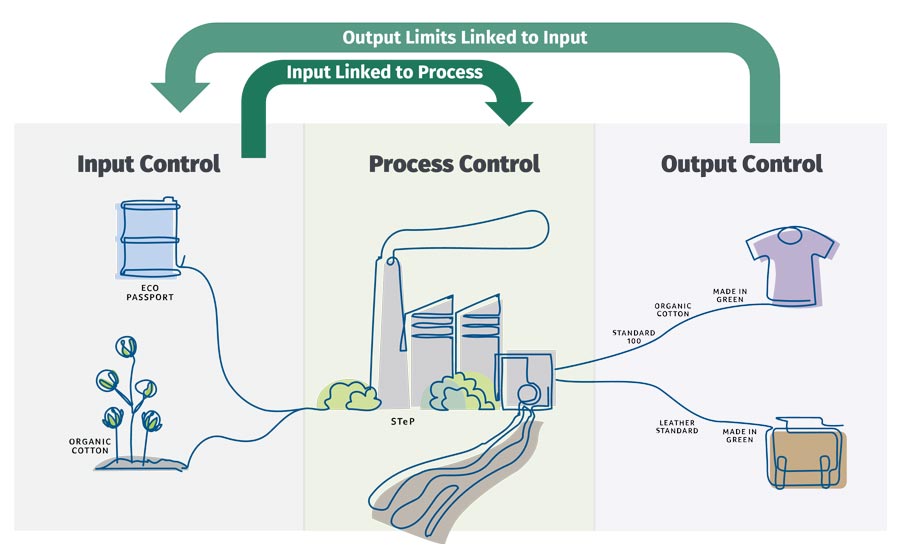
What is tested for STANDARD 100 certification?
The OEKO-TEX® criteria catalogue contains a wide variety of test parameters that consider all ways a substance can be absorbed (skin, mouth, breathing). The central components of STANDARD 100 - requirements, limit values and test methods - are based on science. In many cases, the test criteria and limit values go far beyond applicable international standards and regulations. The inclusion of potentially harmful substances not yet legally regulated reflects the pioneering role.
Does OEKO-TEX® STANDARD 100 prove compliance with regulations and standards?
The substance lists and limit values of the OEKO-TEX® STANDARD 100:
- Ensure compliance with Appendix XVII and appendix XIV of the EU Reach Regulation (EC) No 1907/2006 and EU regulation (EU) 2019/1021 on persistent organic pollutants (POP)
- Cover all substances with textile and leather relevance from European Chemical Agency’s Substances of Very High Concern (SVHC) candidate list
With OEKO-TEX® certification, no communication duties are necessary along the supply chain regarding the SVHC substances. However, for some rare examples of technical requirements where SVHC substances are present and cannot be avoided, this is clearly stated in the scope of the certificate to support mandatory communication. - Ensure compliance with CPSIA total lead requirements
All OEKO-TEX® partner textile laboratories are CPSC (U.S. Consumer Product and Safety Commission) accredited. A laboratory report for OEKO-TEX® STANDARD 100, product class 1, serves as evidence of compliance regarding the total lead content (with the exception of accessories made from glass) in children's products. - Show restricted substance compliance with the NFPA 1970 standard
- Ensure compliance with GB 18401
The OEKO-TEX® product classes are comparable and compliant with all limit values from the GB 18401. However, the GB 18401 contains additional labeling requirements that are not part of the OEKO-TEX® STANDARD 100 criteria catalogue - Are aligned with:
- Apparel and Footwear International RSL Management (AFIRM) Group restricted substance list
- Zero Discharge of Hazardous Chemicals (ZDHC) MRSL
- Other relevant legal regulations and stakeholder MRSL/RSLs
What are the STANDARD 100 product classes?
What is the difference between Annex 4/5 and 6/7?
Annex 4/5 (most common)
- The parameters & defined limit values are based on scientific data to reliably protect human ecological safety. This standard also meets or exceeds global regulations (such as REACH regulations)
Annex 6/7
- The expanded criteria catalogue is for companies focused on the Greenpeace Detox campaign and is required for all textiles in the Greenpeace trial standard
- Prescribes stricter limit values for many test parameters and substances, not for human health, but for improved environmental performance in the production of textiles to align with the Detox campaign
Does OEKO-TEX® test and certify for PFAS?
PFAS are banned in all OEKO-TEX® standards, including STANDARD 100.
As of January 1, 2024, total fluorine testing is required for all product classes (replacing the previous EOF method and covering TOF). The limit value is 100 mg/kg.
Certifying to STANDARD 100 means the product has been tested for the listed substances. We do NOT certify the product as "PFAS-free".
How long is a STANDARD 100 certificate valid?
A STANDARD 100 certificate is valid for 12 months and can be renewed annually. We recommend starting the renewal process up to 3 months before expiration to ensure continuous product safety and smooth process along the OEKO-TEX® certified supply chain. Many downstream certifications are dependent on pre-certified components from suppliers.
How are samples selected for STANDARD 100 testing?
The article description on the certificate is based on a representative selection of samples which must cover the entire product group to be certified. An incomplete sample selection may lead to a restriction of the certified article group.
Does STANDARD 100 require audits? Why?
To ensure consistent safety of certified products, an approved quality management system must be in place. Qualified auditors verify systems during on-site quality assurance meetings. These meetings occur within the first year of certification and every third year thereafter.
Can I use biocides or flame retardant ingredients?
Most biologically active/biocides and flame retardant substances are forbidden from use in OEKO-TEX® certified products.
Exceptions are made for substances on the OEKO-TEX® Active Chemical Products list, which have been examined separately by an OEKO-TEX® partner toxicologist.
What are the supplements for special articles and PPE?
STANDARD 100 supplements are related to very specific market segments and product types with specific requirements.
- Personal Protective Equipment (PPE) and Materials for PPE - exceptions to maintain protective qualities
- Special Articles - for complex finished goods like beds, furniture, stollers, etc.
Contact us to determine if your product falls under a supplement.
How can the STANDARD 100 label be used?
An OEKO-TEX® STANDARD 100 certificate and label are awarded only when all the component parts meet the test criteria. Finished goods must have their own certification, even if all the individual components have already been certified.
Since the STANDARD 100 label is a protected trademark, all companies using the label must comply with the labeling rules. Forgery and misuse of the trademark can be prosecuted under criminal and civil law.
A STANDARD 100 label is only valid if the test number and the responsible testing institute are shown. These details must also correspond to the company’s own certificate.
For B2B purchasers, a STANDARD 100 label applied to a product is not sufficient proof of successful testing. Buyers should always require the supplier to submit a valid OEKO-TEX® certificate. The details on the STANDARD 100 label (test number and test institution) must correspond to those on the certificate and the product must be included in the certificate scope.
Please view the labeling guide and contact us with questions.
How much does STANDARD 100 certification cost?
STANDARD 100 certification fees are made up of:
- License fee - fixed - annual
- Company audit fee - fixed - 1st year, then every 3 years
- Testing fees - variable - annual
- Fees are based on the testing expenses for the specific textile product or material
- Use of pre-certified source materials can significantly reduce laboratory testing for the applicant. The modular system used in STANDARD 100 certification distributes testing costs along the supply chain
- Contact us for a quote based on required testing and pre-certifications
Can small companies use OEKO-TEX®?
Yes! Brands, retailers, manufacturers and suppliers - of all sizes - use the OEKO-TEX® system. Because of the modular design, sourcing pre-certified components eliminates redundant testing (costs) for and makes certification affordable for smaller companies.
Prairie Wear, a small brand, uses OEKO-TEX® in their supply chain and marketing. It has helped them make better decisions, build trust and grow globally.
How do I get the Climate Pledge Friendly label on Amazon?
OEKO-TEX® STANDARD 100 and MADE IN GREEN are trusted certifications for the Climate Pledge Friendly program on Amazon.
To earn the Climate Pledge Friendly label for products sold on Amazon:
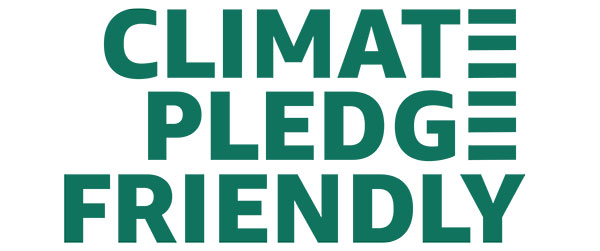
- Complete the Climate Pledge Friendly template (.csv-file)
- Submit the ASINs to Amazon's Vendor Central or Amazon's Seller Central
- Once certified ASINs are validated, Amazon will recognize in the Climate Pledge Friendly program (~10 business days)
How does OEKO-TEX® certify a converting process?
An OEKO-TEX® STANDARD 100 commission certificate is for companies that provide a converting service (e.g. commission dyeing, printing, finishing, coating, washing, etc.), but do not produce the material itself. A converter's commission certificate covers the converting process, but not the material/product. The material would be certified by its supplier.
Certified Converter
Uncertified Converter
Example: Certified Converting Process
Because the OEKO-TEX® system is modular, a commision certificate reduces the testing costs for their customers.
Are OEKO-TEX® certificates traceable?
OEKO-TEX® is based on a modular system. Certification is available for every stage of the textile chain and certificates from prior stages are recognized downstream. This means that costs are shared throughout the supply chain and traceability enhanced.
Is there a STANDARD 100 Hangtag?
Certificate owners can download STANDARD 100 hangtags from myOEKO-TEX® - customized with the label number and institute - and available in several languages.
How does OEKO-TEX® ensure consistent quality?
In addition to internal quality assurance programs, the certified company agrees to the declaration of conformity during application. This agreement allows OEKO-TEX® institutes to conduct control tests.
Each year, Hohenstein control tests at least 25% of certified products. Previously certified materials are re-tested during certification processes for downstream products. Random samples of OEKO-TEX® certified products are purchased from stores and tested again in the laboratory. In addition, independent auditors commissioned by OEKO-TEX® conduct unannounced site inspections to assess on-site quality assurance in the facilities.

